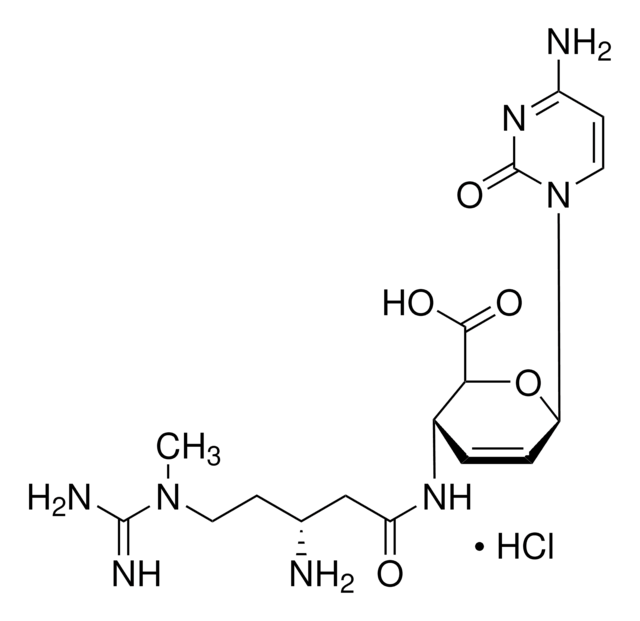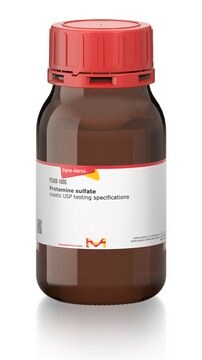540411
Puromycin, Dihydrochloride, Cell Culture-Tested
Puromycin, CAS 58-58-2, is a protein synthesis inhibitor that causes premature release of nascent polypeptide chains.
Sinônimo(s):
Puromycin, Dihydrochloride, Cell Culture-Tested
About This Item
Produtos recomendados
Nível de qualidade
Ensaio
≥98% (HPLC)
forma
solid
fabricante/nome comercial
Calbiochem®
condição de armazenamento
OK to freeze
desiccated
Impurezas
≤10 EU/mg Endotoxin (dry weight)
cor
white to off-white
solubilidade
methanol: 20 mg/mL
water: 50 mg/mL
Condições de expedição
ambient
temperatura de armazenamento
−20°C
InChI
1S/C22H29N7O5.2ClH/c1-28(2)19-17-20(25-10-24-19)29(11-26-17)22-18(31)16(15(9-30)34-22)27-21(32)14(23)8-12-4-6-13(33-3)7-5-12;;/h4-7,10-11,14-16,18,22,30-31H,8-9,23H2,1-3H3,(H,27,32);2*1H/t14-,15+,16?,18+,22+;;/m0../s1
chave InChI
MKSVFGKWZLUTTO-USYAMCSGSA-N
Descrição geral
Ações bioquímicas/fisiológicas
protein synthesis
Advertência
Reconstituição
Outras notas
Kaufman, S.H., et al. 1993. Cancer Res.53, 3976.
de la Luna, S. and Ortín, J. 1992. Methods Enzymol.216, 376.
Chow, S.C., et al. 1991. Exp. Cell Res. 216, 149.
Informações legais
Palavra indicadora
Warning
Frases de perigo
Declarações de precaução
Classificações de perigo
Acute Tox. 4 Oral
Código de classe de armazenamento
11 - Combustible Solids
Classe de risco de água (WGK)
WGK 3
Ponto de fulgor (°F)
Not applicable
Ponto de fulgor (°C)
Not applicable
Certificados de análise (COA)
Busque Certificados de análise (COA) digitando o Número do Lote do produto. Os números de lote e remessa podem ser encontrados no rótulo de um produto após a palavra “Lot” ou “Batch”.
Já possui este produto?
Encontre a documentação dos produtos que você adquiriu recentemente na biblioteca de documentos.
Os clientes também visualizaram
Nossa equipe de cientistas tem experiência em todas as áreas de pesquisa, incluindo Life Sciences, ciência de materiais, síntese química, cromatografia, química analítica e muitas outras.
Entre em contato com a assistência técnica













